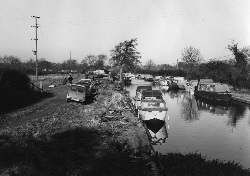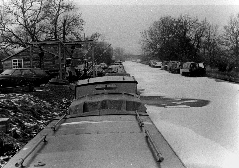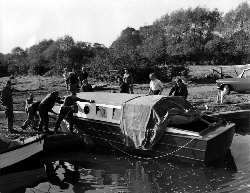|
The Black Buoy Cruising Club (BBCC) was formed in 1963.
Obviously the close proximity of the Black Boy pub was the inspiration.
The subtle change was probably made to demonstrate that the club was, and
still is, a separate entity. Unfortunately it is sad that the identity of the
person responsible
for this clever pun has been lost in the obscurity of time.
Since at least 1953, pleasure boats had regularly moored
by bridge 69
outside the Black Boy pub. A little further along near bridge 70, another
group of boats moored by the Heron's Nest
pub, at that time
known as the Cat in the Window.
In the early 1960s, British Waterways began to demonstrate it's
interest in the formation of boating organisations to be run by members as
‘clubs’ and not by adjacent business interests.
 In 1963, ten boaters from the two groups of boats, agreed to the formation
of a boat club. Each
founder contributed £10 to cover the cost of setting up the club
at the present site.
One condition was this subscription was to be refunded once the club,
was up and running. In fact, this did not happen until 1968!
British Waterways granted a lease on the site at an annual rate of
£40.
In 1963, ten boaters from the two groups of boats, agreed to the formation
of a boat club. Each
founder contributed £10 to cover the cost of setting up the club
at the present site.
One condition was this subscription was to be refunded once the club,
was up and running. In fact, this did not happen until 1968!
British Waterways granted a lease on the site at an annual rate of
£40.
In 1964 the very first AGM of the BBCC was held. At that time
membership plus twelve months moorings would cost boaters the
equivalent of £1.25 today, irrespective of boat length!
The prime moorings at this time were on the towpath side of the canal.
The opposite side consisted of a series of little shallow ‘bays’ and
when boats (mainly small wooden cruisers) were taken out of the water
they were hauled up the bank with a bale of straw as a cushion.
The first clubhouse on the site, a small (20 foot by 12 foot) hut,
was provided by British Waterways.
It was taken down plank by plank at a site in Wharf Lane,
Tyseley, transported in a ‘George Mason’s’ grocery van
and re-assembled at the club site.
It was located where the caravan is now (another account says it
was where the garage is).
To speed up the painting of the inside of the hut, one of the members offered the use
of a pressure sprayer. This was fine until the sprayer burst it's seams and
painted all those members unfortunate to be in the vicinity at the time.
The old hut was heated by a solid fuel stove,
assisted by a 12 volt fan. It was not unusual for the hut to be filled with
smoke for an hour or so after the stove was first lit.

The second and more recent clubhouse was purchased by the
club in 1971 for the princely sum of £70. It was a former
clubhouse of Shirley tennis club and like its predecessor was
dismantled and reassembled at the club. At Shirley it
consisted of four main sections, however, only three of
these were in a fit state to re-erect at Black Buoy.
One weekend the brick piers on which it stands were built,
the following the building was collected from Shirley on the Saturday
and rebuilt on the Sunday.
Today the same structure
continues to form the backbone of the clubhouse even though it has
been extended here and there.
One of the main extensions is the kitchen, this was financed by
a series of social fund-raising events, without taking anything
from the club's main funds.
Over the summer of 2001 a new central heating system was installed.
British Waterways also provided the slipway.
 When this was first
constructed it jutted out from the bank like a jetty, such was the state
of the canal bank. A club member acquired some railway line
and a set of bogies from a site in Nuneaton and these were used
to build a slipway trolley to enable boats to be more easily removed from the
water.
When this was first
constructed it jutted out from the bank like a jetty, such was the state
of the canal bank. A club member acquired some railway line
and a set of bogies from a site in Nuneaton and these were used
to build a slipway trolley to enable boats to be more easily removed from the
water.
In the early days,
most of the small boats were removed from the water
at the end of the autumn (an exercise called ‘boats-out’);
then replaced in the water at the start of spring (‘boats-in’).
In 1966 the club acquired a tractor and trailer for this purpose.
The tractor came from Newhaven, costing £65 plus £10
for transport.
The trailer was donated by a member of the club.
At around the same time the shale was placed on the driveway from bridge 69 to the clubhouse.
This arrived by narrowboat, at £27 per load plus £2.50 for
unloading by the crew of two, each load took two and half hours to
shovel out.
The first electric power on the site was provided by an ex-War Department
generator, purchased for £50 from the boatyard at the top of Knowle
Locks. The tractor and trailer were used to collect it,
this was probably the last road journey for the tractor as it
produced plenty of smoke and flames on the trip.
When at a later date, the electricity supply company (at that time the MEB)
provided an upgrade supply to the Black Boy pub, the club were
given permission to have a mains connection from this.
At some time one of the club members required a crane to fit a new
engine into his boat. An old milk-float chassis was available, and this
had a anchor winch and jib fitted. The jib was laboriously
fabricated using a hacksaw and a hand drill.
This crane gave sterling service, but finally was retired in 2001.
During 1976
the gantry over the slipway was constructed.
This was built from parts of an old car body plant which was donated to the club.
Erection took place with the aid of an old fire brigade ladder, acquired
from Moseley Road fire station.
In 1974 the club site was split, not physically, but by the ‘new’
county boundary. The clubhouse and the off-side south of the brook are
in Warwickshire, whereas the rest of the off-side and all of the towpath side
are in the Metropolitian Borough of Solihull, part of the West Midlands county.
The boundary follows the centre line of the canal for nearly a mile south of
bridge 69.
If you know any more details of the club's history, or
if you can provide exact dates for the
photographs, please
contact the webmaster.
|